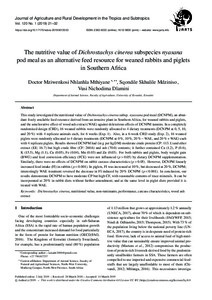| dcterms.abstract | This study investigated the nutritional value of Dichrostachys cinerea subsp. nyassana pod meal (DCNPM), an abundant freely available feed resource derived from an invasive plant in Southern Africa, for weaned rabbits and piglets, and the ameliorative effect of wood ash extract (WAE) against deleterious effects of DCNPM tannins. In a completely randomised design (CRD), 16 weaned rabbits were randomly allocated to 4 dietary treatments (DCNPM at 0, 5, 10, and 20 %) with 4 replicate animals each, for 6 weeks (Exp. 1). Also, in a 6-week CRD study (Exp. 2), 16 weaned piglets were randomly allocated to 4 dietary treatments (DCNPM at 0 %, 10 %, 20 %−WAE, and 20 %+WAE) each with 4 replicate piglets. Results showed DCNPM had (in g per kg DM) moderate crude protein (CP: 113.1) and ether extract (EE: 16.7) but high crude fibre (CF: 260.6) and ash (70.0) contents; it further contained Ca (1.2), P (0.6), K (15.5), Mg (1.1), Cu (0.05), Fe (0.04), Mn (0.03) and Zn (0.03). For both rabbits and piglets, body weight gain (BWG) and feed conversion efficiency (FCE) were not influenced (p > 0.05) by dietary DCNPM supplementation. Similarly, there were no effects of DCNPM on rabbit carcass characteristics (p > 0.05). However, DCNPM linearly increased feed intake (FI) in rabbits (p < 0.001). In piglets, FI was increased at 10 %, but decreased at 20 %, DCNPM; interestingly WAE treatment reversed the decrease in FI induced by 20 % DCNPM (p < 0.001). In conclusion, our results demonstrate DCNPM to have moderate CP but high CF, with reasonable contents of trace minerals. It can be incorporated at 20 % in rabbit diets without further amendment; and at the same level in piglet diets provided it is treated with WAE. | eng |

